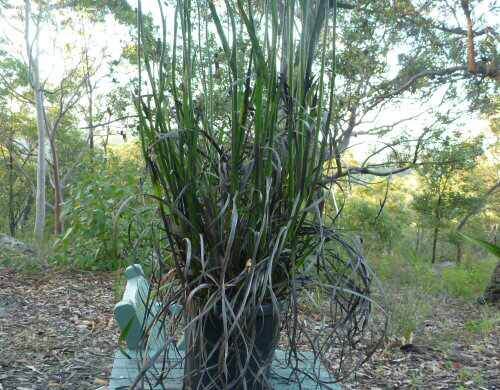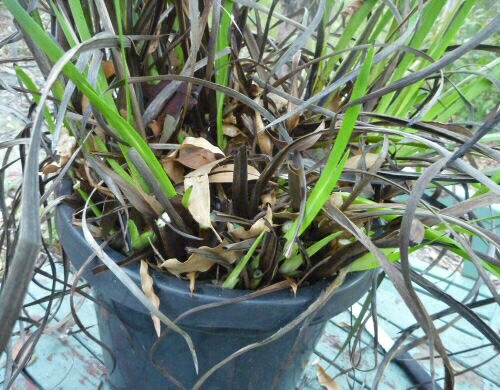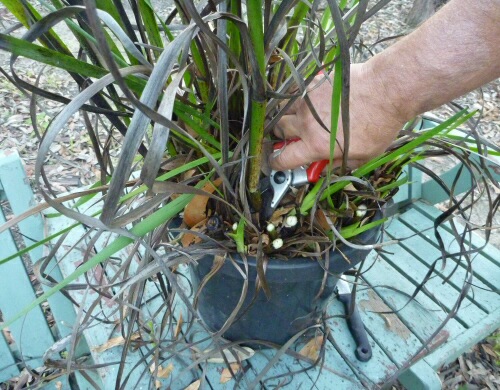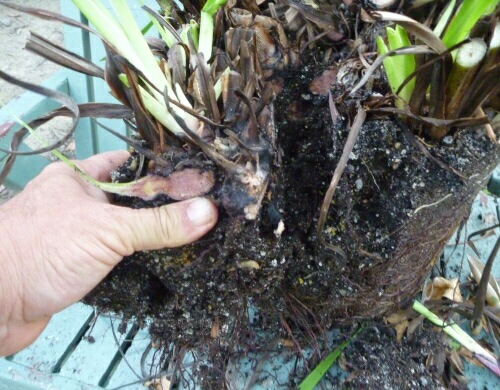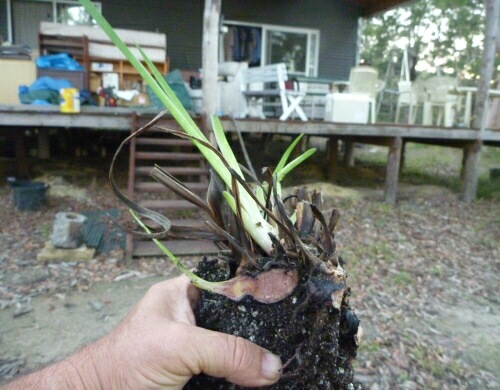Many perennials that are clump forming such as agapanthus, daylilies, irises and kangaroo paws can be successfully divided in late winter, just before the new spring growth. Lift the clumps from the ground with a garden fork or spade and shake off most of the soil. Cut away dead flowers and leaves and pull the clumps apart if possible (an old bread knife is a good tool if the clumps cannot be easily separated). The best results will be achieved by retaining at least 3 shoots in the divided pieces. Cut the foliage in half to reduce the water stress after replanting. The new clumps can go straight back into the garden but a better result is often obtained by allowing them to re-establish in pots in a sheltered position until they are showing signs of new growth.
A Step By Step Guide To Dividing A Kangaroo Paw
The spring flowering had been magnificent and abundant on the plant above, but with old dead flowers and old leaves dying off, it looks rather unsightly now. The plant is trying to bust out of the large pot- a definite sign that it’s not on it’s last legs though….
In the picture above you can see fresh new shoots that are being hidden by the old growth. They will benefit from more light and air, and more space, and from fresh soil.
The first step is to cut away all the old flower stems, nice and close to the base of the plant, and then cut or pull off the untidy leaves. This is a good time to remove any blackened leaves that may be affected by stress or ink spot disease too. Now, knock the plant out of the pot, or dig it up if it is in the garden. If the plant is difficult to remove from the pot, wetting thoroughly can help. If it is in a plastic pot, you may need to turn it on its side and give a few sharp blows to the sides of the pot to loosen the plant. Also inspect any roots that may be large enough to be causing problems at the drainage holes, often these need cutting away too.
You can see the rhizomes on this kangaroo paw once you start cutting into the plant- they are the swollen and fleshy looking structures just below the surface. Rhizomes store food for the plant, and contain the new growth buds, which is why you can take a lawn mower or whipper snipper to a kangaroo paw in a display of impressive extreme gardening, and it will bounce back again. A great trick to impress the neighbours, and timid fellow gardeners, as well as a nice bit of easy gardening.
You can see in the above picture how I’ve taken the trusty bread knife to the clump. Before you start cutting, have a look for a nice cutting point, which will be in between the shooting points….you want to avoid cutting into your healthy shoots if possible. It is a good idea to include a couple or more healthy looking shoots in each section so as to give the new plant a good start. Cut downwards to separate a good sized section. This ensures you get as much soil as you can along with the clump. Sometimes the dirt will fall away from the plant, but as long as the division is not left unplanted for too long, this should not be a problem. If the soil does fall away, you need to be sure to fill the space around the newly planted roots with soil. The way to do this is to ensure you water in well once you add new soil. You may need to add more soil around the plant if the level drops after watering.
And there you have it. One new plant, ready for it’s next home. I got four divisions from this one plant. Once planted into a new pot or in the garden, water it in with a seaweed based tonic, as they contain natural hormones that will encourage root growth. A good time to divide plants is in autumn, as it lets them settle down and grow a healthy root system to support lots of new spring growth.

